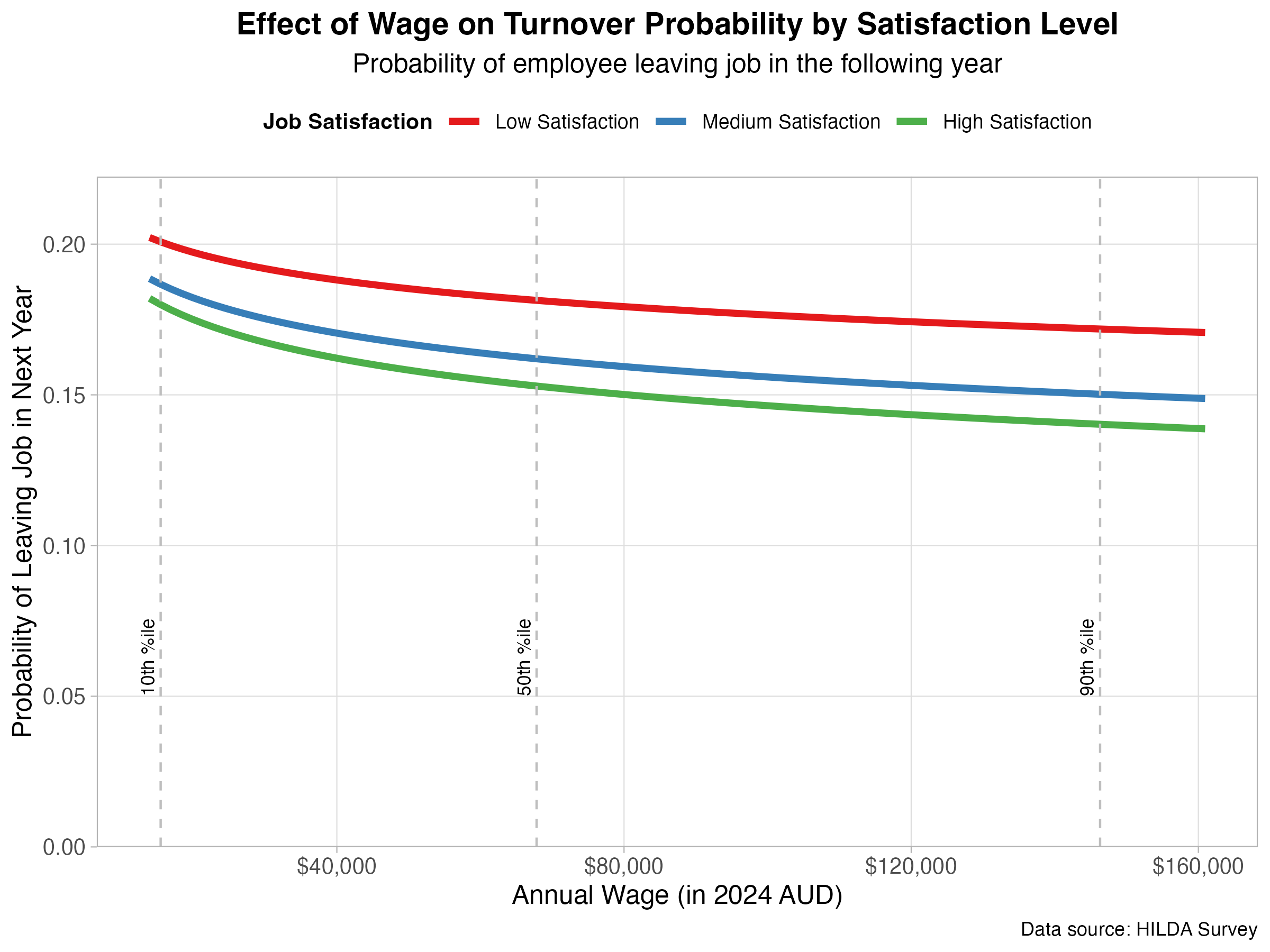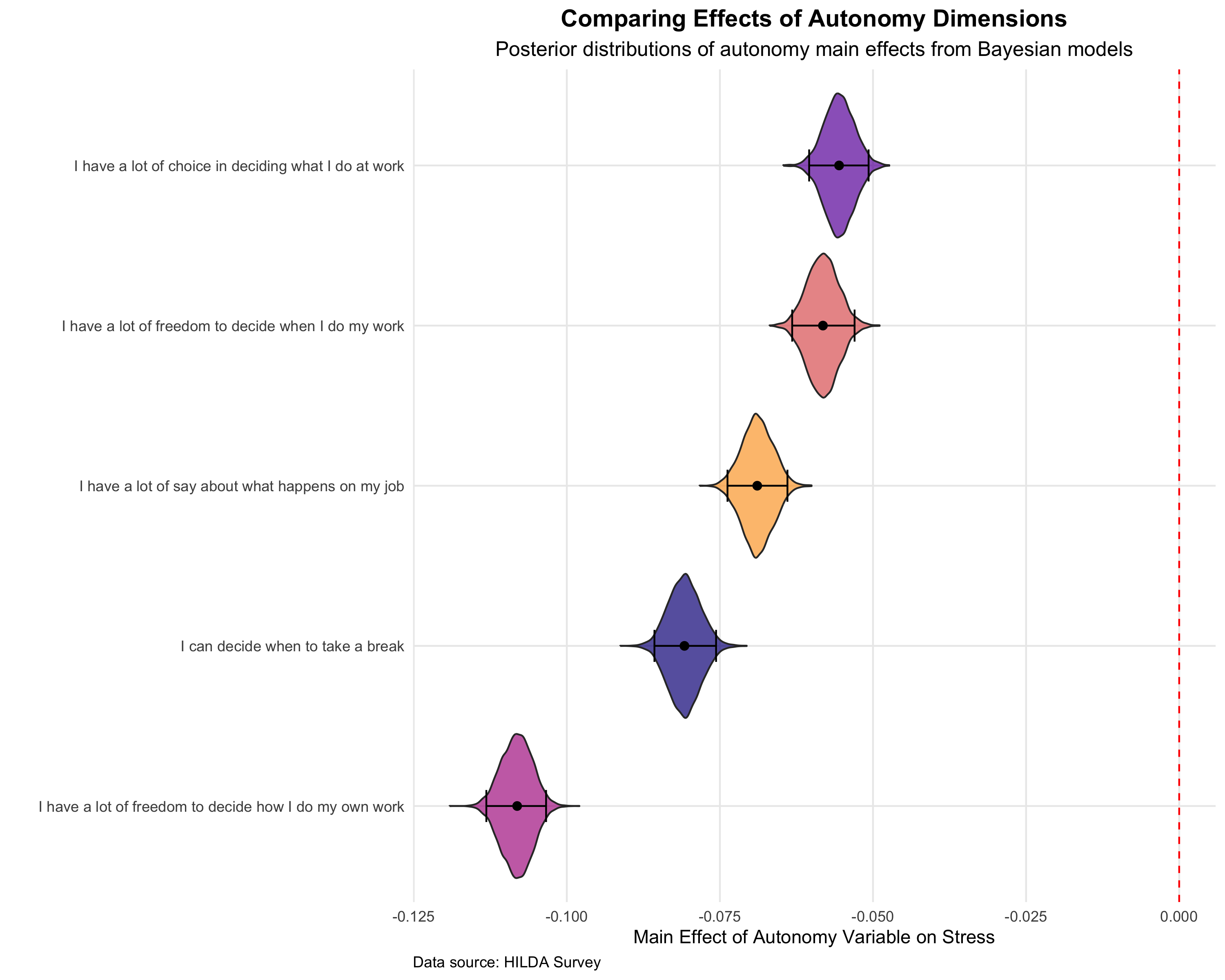It’s Not (Just) About the Money: Why Job Satisfaction Beats Salary in Employee Retention
You offer a star employee a generous pay rise – yet a few months later, they hand in their resignation. It’s a scenario business leaders dread, and it highlights an important question: what really makes employees stay or go? A new analysis of Australian workplace data suggests the answer isn’t simply a bigger pay cheque. In fact, findings from the HILDA survey (Household, Income and Labour Dynamics in Australia) reveal that while higher wages do modestly reduce turnover, job satisfaction is a far stronger predictor of whether an employee will still be with you next year.
Wages vs. Satisfaction – What the Data Show
Using data from the HILDA survey, Australia’s nationally representative household-based panel study that has tracked the same individuals since 2001, we fitted a generalised linear mixed effects model to predict the probability of an employee leaving their job in the following year. Our analysis of 20,496 individuals incorporated job satisfaction levels, annual wages (adjusted to 2024 AUD), and their interaction, while controlling for age and gender effects. The resulting analysis, visualised in the graph below, shows the predicted probability of turnover across different wage levels for three satisfaction groups (10th, 50th, and 90th percentiles of reported satisfaction).

Our analysis revealed two key patterns in employee retention. First, wages matter most at lower income levels - increasing pay from the 10th to 50th percentile significantly reduces turnover risk. However, beyond median income, further pay increases have diminishing returns. Second, and more importantly, job satisfaction emerges as the dominant factor in retention. Even at high income levels (90th percentile), employees with low job satisfaction are more likely to leave than moderately satisfied employees earning median wages. This finding is particularly striking: throwing money at retention problems simply doesn’t work if employees are fundamentally dissatisfied with their jobs. This aligns with past research showing a strong link between job satisfaction and employees’ intention to stay. Once employees feel under-appreciated or disengaged, a pay rise alone often isn’t enough to retain them.
Beyond the Pay Cheque: Why Engagement Matters More
These insights carry an important message for organisations and HR professionals: engagement strategies must go beyond salary. Of course, fair compensation is fundamental – consistently underpaying will drive good people away. However, if you’re trying to reduce turnover, focusing solely on salary is unlikely to be the best solution. A competitive salary might get candidates in the door, but it won’t keep them engaged year after year if their everyday work experience is poor. What truly moves the needle on retention are factors that boost day-to-day satisfaction: a positive workplace culture, supportive management, recognition for good work, growth and development opportunities, and work-life balance. In fact, a Gallup study found that 42% of employees who quit said their manager or organisation could have done something to prevent them from leaving. This suggests many resignations aren’t inevitable – they’re a reflection of needs and concerns going unmet. Employees often leave because they’re seeking engagement and fulfilment that they aren’t getting in their current role, not just because another company is waving a slightly bigger pay cheque.
Predicting (and Preventing) Turnover Risk
For HR teams, one practical implication is the value of measuring and monitoring employee satisfaction. Engagement surveys, pulse checks, and honest conversations can identify if someone’s morale is low long before they decide to exit. By tracking indicators like job satisfaction, managers can predict turnover risks more accurately than by monitoring salaries. An employee who indicates low engagement or dissatisfaction is waving a red flag – even if they’re well-paid – and it may be time for intervention. On the flip side, if you know someone loves their job but is underpaid relative to market, you have a window to adjust their compensation before they start looking elsewhere. In light of these findings, here are some retention tips for leaders and HR professionals:
- Invest in a great employee experience: Ensure managers are trained to support, listen, and provide feedback. A respectful culture where people feel valued can significantly raise job satisfaction.
- Provide growth opportunities: Clear career pathways, training, and new challenges keep employees excited and motivated – factors that salary alone can’t buy.
- Conduct regular check-ins: Don’t wait for the exit interview to find out why an employee was unhappy. Routine one-on-one meetings and engagement surveys help identify issues early.
- Offer fair and transparent pay: While salary isn’t everything, perceived unfair pay can fuel dissatisfaction. Make sure your remuneration is competitive and transparent so that pay isn’t a point of bitterness.
The Bottom Line
Higher wages can help reduce employee turnover – but they are not the most powerful factor keeping your talent onboard. If your goal is to hang on to your best and brightest, focus on cultivating high job satisfaction. That means building an environment where people want to come to work, not just one that pays them to. Competitive paychecks matter, but engaging work, supportive managers, and growth opportunities matter more in the long run.




